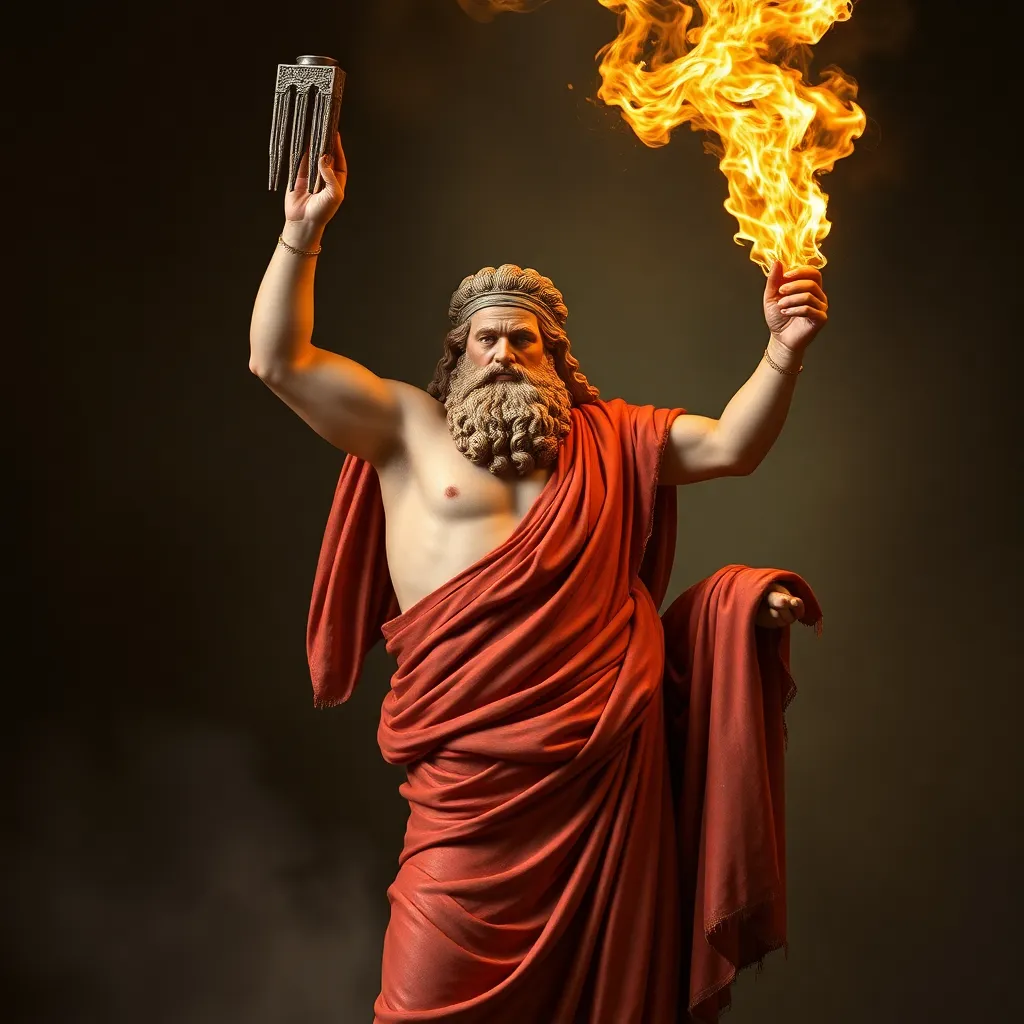Hephaestus in Art: How Ancient Artists Depicted the God of Fire
I. Introduction
Hephaestus, the Greek god of fire, craftsmanship, and metallurgy, occupies a unique position in Greek mythology. As the divine blacksmith, he is credited with creating magnificent weapons and armor for the gods and heroes, embodying the intersection of creativity and technical skill. His character, often portrayed as physically imperfect yet brilliant, challenges conventional notions of beauty and strength in mythology.
Artistic representations of Hephaestus provide insight into how ancient Greeks viewed craftsmanship, innovation, and the complexities of divine relationships. Through various mediums, artists captured his essence, contributing to our understanding of societal values and cultural narratives in ancient Greece. This article explores the diverse depictions of Hephaestus in ancient art, revealing the layers of meaning and significance that surround this multifaceted god.
II. Historical Context of Hephaestus
Hephaestus’s origins in Greek mythology are rich and complex. He is often described as the son of Zeus and Hera, although some versions of the myth suggest that he was born from Hera alone. Despite being cast from Olympus due to his physical deformities, Hephaestus became a vital figure in both mythology and society.
His role in ancient Greek religion was significant; he was revered as the patron of artisans and craftsmen, influencing the practices of metallurgy and sculpture. Temples dedicated to Hephaestus, such as the one in Athens, served as centers for worship and craftsmanship. His influence extended beyond divine realms, impacting the daily lives of people who relied on his gifts for trade and industry.
III. Iconography of Hephaestus
Hephaestus is commonly associated with a variety of symbols that embody his identity and skills:
- Hammer: A primary tool of the blacksmith, symbolizing creation and craftsmanship.
- Anvil: Represents the foundations of metallurgy and the hard work of forging.
- Fire: A crucial element of his craft, signifying both creation and destruction.
Artistically, Hephaestus is often depicted with distinctive physical traits, including a robust form and noticeable disabilities, which serve to highlight his uniqueness among the gods. This portrayal contrasts sharply with the idealized forms of other deities, emphasizing the theme of inner strength and talent over outer perfection.
When compared to other gods, such as Apollo or Zeus, Hephaestus’s iconography is marked by a focus on tools and labor rather than divine power, showcasing a different aspect of the divine experience.
IV. Major Artistic Representations in Ancient Greece
Hephaestus was depicted across various artistic mediums in ancient Greece:
A. Pottery and ceramics
Vases and amphorae frequently featured scenes of Hephaestus at work or interacting with other gods. These depictions often included dramatic narratives, emphasizing his role in creating iconic artifacts.
B. Sculpture
Notable statues and reliefs of Hephaestus can be found in ancient temples, showcasing him in action or alongside other deities. The famous bronze statue of Hephaestus created by the artist Calamis is a prime example of the reverence accorded to him in sculptural art.
C. Frescoes and wall paintings
Hephaestus also appeared in frescoes adorning domestic and public spaces, illustrating his significance in everyday life and worship. These artworks often depicted his relationships with other Olympian gods, particularly Aphrodite, highlighting the narrative richness of his character.
V. Hephaestus in Roman Art
As Greek mythology transitioned into Roman culture, Hephaestus was adapted into the figure of Vulcan. While both gods shared similar roles as patrons of fire and craftsmanship, there are key differences in their portrayals:
- Differences: Vulcan was often depicted with a more martial appearance, reflecting Rome’s militaristic culture.
- Similarities: Both gods were associated with forges and craftsmanship, symbolizing the human endeavor to harness fire for creation.
Roman art continued the tradition of depicting Vulcan with tools and in scenes of creation, influenced by the existing Greek iconography while integrating elements of Roman values and aesthetics.
VI. Thematic Interpretations of Hephaestus in Art
The representations of Hephaestus in art carry profound thematic interpretations:
A. Hephaestus as a symbol of craftsmanship and innovation
His depictions often celebrate the virtues of hard work and ingenuity, portraying him as a model for artisans and creators.
B. Representations of his relationships with other gods and goddesses
Particularly with Aphrodite, Hephaestus’s relationships illustrate themes of love, jealousy, and betrayal, adding depth to his character and highlighting the complexities of divine interaction.
C. The duality of creation and destruction
His association with fire embodies the dual nature of his craft—while he creates beautiful and powerful artifacts, fire can also lead to destruction. This duality is a central theme in many artistic representations.
VII. Legacy and Influence on Later Art
The legacy of Hephaestus extends far beyond ancient Greece and Rome, influencing various art movements through the ages:
A. Continuation of Hephaestus’s themes in Renaissance and modern art
Renaissance artists revisited classical themes, often incorporating Hephaestus as a representation of human creativity and labor.
B. Impact on literature and popular culture
Hephaestus’s character has inspired numerous literary works and remains a popular figure in modern storytelling, symbolizing the power of creation and the struggles of the artist.
C. Hephaestus as a source of inspiration for contemporary artists
Today, many artists draw upon the rich symbolism of Hephaestus, exploring themes of craftsmanship, innovation, and the human condition in their works.
VIII. Conclusion
In summary, the depictions of Hephaestus in ancient art offer a window into the values and beliefs of Greek society. His portrayal as a skilled craftsman with complex relationships highlights the dualities of creation and destruction, beauty and imperfection. The enduring significance of Hephaestus in art and culture invites further exploration of the dynamic interplay between mythology and artistic expression, encouraging us to reflect on the timeless themes of creativity and human endeavor.
As we continue to study and appreciate ancient art, Hephaestus stands as a powerful reminder of the importance of innovation and the artistic spirit throughout history.




